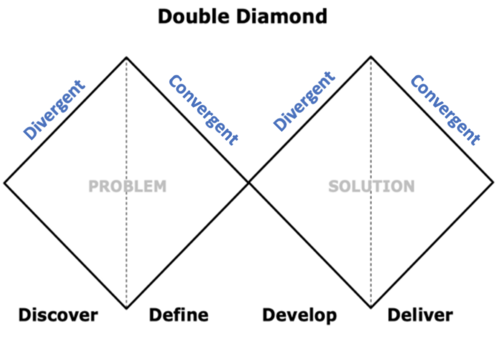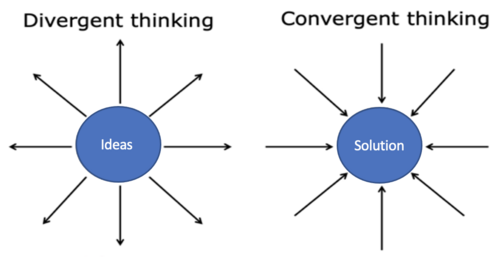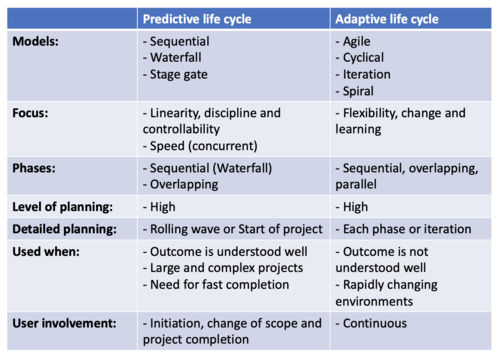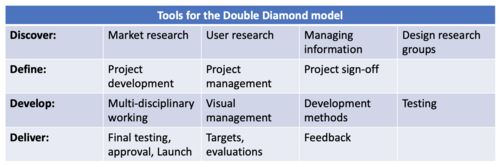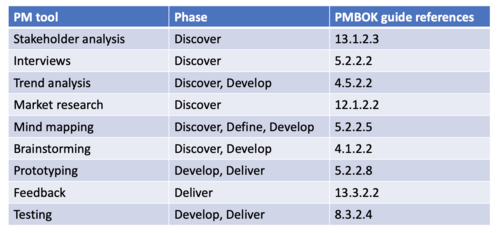Double diamond: A design process model
Contents |
Abstract
This article describes the Design Thinking model Double Diamond with a particular focus on how the model is applicable in the context of project management and what limitations it holds. The Double Diamond model was developed by the British Design Council in 2005 based on case studies from Design Departments at 11 international companies[1]. The model was visualized by a figure consisting of two diamonds, in which the first diamond displayed the problem space and the second the solution space. The Double Diamond model describes four general stages, which can help the user to navigate through complex processes in a structured manner. Each of the four stages are characterized by what has been described as either divergent- or convergent thinking: Discover (Divergent), Define (Convergent), Develop (Divergent), and Deliver (Convergent). Thus, the principle is that the user is diverging before converging. The initial Discover-stage aims to investigate, explore and identify the stakeholder needs while simultaneously seeking to understand the complexity of the problem. The Define-stage delimits the interpretations based on the findings in the Discover-stage, aiming to obtain a clear definition of the problem. The third stage, Develop, aims to acquire various solutions, which can address the problem. The Deliver-stage entails final testing of the solutions pursuing an improved outcome followed by feedback sessions on the process. Connecting the model to the different project management life cycles shows that the Double Diamond is not a great fit for all types of life cycles, however the model still appears to be an appropriate Project Management framework in some cases, e.g., when running a project in a predictive life cycle aiming to obtain a structured project plan with a key focus on the problem- and solution space from the initial stages. Further, it is discussed that the model contains certain limitations, e.g., its structure has been criticized for being too linear, which does not align with today’s agile and iterative way of applying Design Thinking or Project Management.
The Double Diamond in the context of Project Management
Design Thinking & Project Management
The Double Diamond model was developed by the British Design Council in 2005 based on the concept of Design Thinking, which is defined and described by various authors. However, the majority of the authors, who have been involved with Design Thinking, associate the concept with subjects such as creative processing, problem solving and business innovation[2]. IDEO, an international design and innovation consulting firm, describes Design Thinking as followed:
“Design thinking has a human-centered core. It encourages organizations to focus on the people they're creating for, which leads to better products, services, and internal processes. The process starts with taking action and understanding the right questions. It’s about embracing simple mindset shifts and tackling problems from a new direction.“[3]
The Design Thinking approach fits well in the context of Project Management as it facilitates and encourages innovative solutions based on mainly human resources. Many common denominators exist between the two approaches, which is why the Design Thinking model Double Diamond can be tied to several specific processes within Project Management. The model discussed in this article fits the structuring and planning of Project Management, why the different life cycle concepts are reviewed based on the Project Management standards[4][5]. Specifically, it is addressed how the Double Diamond is applied in a predictive or adaptive life cycle.
The Double Diamond & Project Management
The Double Diamond model involves four phases. The first two phases constitute the first diamond - the problem space. The other two phases constitute the second diamond - the solution space. Figure 1 visualizes the Double Diamond model.
As illustrated by Figure 1, each of the four phases in the model are characterized by either divergent- or convergent thinking. Divergent thinking entails a process aiming to generate several creative and innovative ideas whereas convergent thinking subsequently structures and narrows down the ideas (and information) into an optimal solution to the problem[6]. Figure 2 visualizes the concept of divergent- and convergent thinking:
The Double Diamond model stipulates the user to diverge before converging, making it a great framework to structure- or plan a project. However, it must be supplemented by other design and project management tools and methods to succeed in this. The Double Diamond is particularly beneficial due to the early and thorough attention paid to the problem- and solution space, e.g., when developing a new product or service in an organization[1]. When applied, one should initiate from the left in the first quarter of the diamond, sequentially processing through each of the phases until finished. The British Design Council describes the Double Diamond as followed:
“The two diamonds represent a process of exploring an issue more widely or deeply (divergent thinking) and then taking focused action (convergent thinking).“[6]
By now it should be clear that the Double Diamond model in fact is a sequential processing framework. While there exist countless of different versions of the Double Diamond model, this article is concerned with the original model developed in 2005. The model was developed on the basis of a very large study, which resulted in an enormous amount of factual literature to carry out the research. In fact, the British Design Council developed a new, more complex version of the original model, changing the name to the Framework for Innovation[6]. The Framework for Innovation may be considered as the current state of the art on this topic; this is further addressed in the end of this section as well as in Section 3, when assessing if there are any limitations tied to the Double Diamond.
The project life cycle
It is important for the user to understand, which type of life cycle the Double Diamond model can be applied to. Theory on the life cycle is therefore explained based on the PMBOK guide and PRINCE2 standards. Despite the fact that each project consists of unique tasks and processes, every project contains a life cycle, which include different project phases between the initiation- and completion of a project[4]. The PMBOK guide defines a project phase as "a collection of logically related project activities that culminates in the completion of one or more deliverables."[7]. The phases in a life cycle can be sequential, iterative, or overlapping[7]. The PMBOK guide similarly defines the project life cycle as "the series of phases that a project passes through from its start to its completion."[7]. ISO 21500 agrees on the definition[8]. Further, the structure of a project life cycle entails the following four generic phases according to the PMBOK guide:
- "Starting the project
- Organizing and preparing
- Carrying out the work
- Closing the project"[7]
PRINCE2, the British standard of project management, defines the project life cycle structure as the following stages:
- "Initiation stage
- Subsequent stage(s)
- Final stage"[9]
There might only be two stages in a life cycle depending on the particular project, e.g., if the project is simple, it would only consist of an initiation- and a completion (final) stage[9]. A project life cycle can either be adaptive or predictive.
Predictive & adaptive life cycles – which is the better fit for the Double Diamond?
The predictive life cycle, also known as the waterfall life cycle, is characterized as being rigid and sequential whereas the adaptive life cycle is characterized as being agile, iterative, and sometimes hybrid, implying a combination of predictive and adaptive approaches[7]. In the adaptive life cycle, projects are broken down into smaller, progressively repetitive phases, which corresponds with the PMBOK guide referring to it as the "agile or change-driven life cycle"[7]. Table 1 visualizes the differences between the two types of life cycles.
Naturally, the Double Diamond is a better fit to apply in the predictive life cycle due to the linear and sequential processes incorporated into the model. When applying the Double Diamond model, the user sequentially processes through each of the four phases starting from the Discover phase. If the project life cycle does not support the sequential or linear structure of the model, it may be difficult to navigate in this process, e.g., a project, which takes place in a rapidly changing environment can be challenging to structure applying the Double Diamond. Nevertheless, it may be applied in an adaptive life cycle, despite the fact that the British Design Council only included a single example of a company that used an agile approach in their study on developing the Double Diamond processing model[1]. The company used in the study is Yahoo!, and one of their employees commented the following: “Yahoo! has a ‘one size doesn't fit all’ attitude towards the concept of a formalised design process.”[1], which was a direct statement against the development of the Double Diamond model.
The Framework for Innovation
The British Design Council has developed an evolved version of the Double Diamond model, which has been given the name: The Framework for Innovation[6].
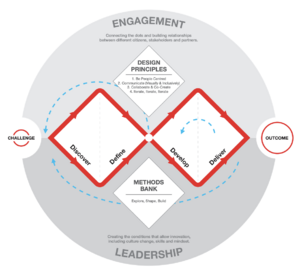
As seen in Figure 3, the framework is still visualized as two diamonds and includes the identical four phases. However, the Framework for Innovation differs from the Double Diamond model by the British Design Council explicitly emphasizing that “This is not a linear process as the arrows on the diagram show”[6]. Besides the newly added arrows, they also enhanced the complexity of the model by including the following factors to promote innovation[6]:
- Engagement
- Design Principles
- Methods Bank
- Leadership
The Framework for Innovation appears to be a better fit for the adaptive life cycle than the Double Diamond model is. The expanded version includes newly added components, which might affect the model negatively as it becomes complicated and time consuming to use. A strength of the Double Diamond is in fact the degree of simplicity, where the user is thinking divergently before thinking convergently, which relates to the problem- and solution space.
Application
So far, the article has identified that the Double Diamond model is better suited to a predictive life cycle than an adaptive life cycle. However, the model is still applicable in all types of industries even if there are areas for which it is better suited, e.g., industries and projects that run in a rigid sequence, which typically characterizes a predictive life cycle. On the contrary, the Double Diamond model is not particularly well suited for projects that require a high degree of flexibility, or that lack significant data at the beginning of the project, e.g., projects dealing with software development[1]. Concrete tools and methods for the team to apply during the different phases are enlightened in the end of the section, respectively in Table 2 and Table 3.
Problem space
Discover phase
The Discover phase corresponds to the beginning of a project, which is characterized by divergent thinking in which the user must examine a wide range of problems, user needs and opportunities. As mentioned previously in the article, divergent thinking entails generating numerous new ideas and gathering new information, which is the objective in this phase as well, however the focus is on the problem space[1].
Define phase
In the Discover phase, all data and information were gathered to identify a problem, thus a combination of this new knowledge, insights and ideas can be analyzed and structured in the Define phase. Here, convergent thinking should be used to structure, separate and narrow down the information gathered in the Discover phase such as the user needs, competitive environments, trends and market data. When going through the phase, it is essential to ensure that everyone related to the project, both internally and externally, agrees on the context of the project before moving on to the next phase[1].
Solution space
Develop phase
The Discover- and Define phases are completed constituting the first diamond of the model, which has the objective of obtaining new insights, identifying, and understanding the problem. The objective in the Develop phase is to generate ideas, which seek to solve the problem identified. The solutions are transformed into prototypes and tested on a continuous basis during the Develop phase[1].
Deliver phase
In the Deliver phase, the solution is near completion and set to go through the closing steps. The objective is to complete final testing, production, launching and evaluations. The latter makes the user reconsider whether the process in fact was a success or not. This may result in valuable information on how to improve future projects, e.g., whether the application of methods involved in each of the phases have been performed appropriately[1].
Concrete tools & methods to apply in the four phases
The following section provides a guidance on concrete tools and methods, which can be applied during each of the four phases. Just as there are different variants of the Double Diamond, there are also several different suggestions for methods and tools to be applied during each phase. Table 2 outlines the tools needed in each phase of the Double Diamond according to the British Design Council. Each tool can be further studied in ‘A study of the design process'[1].
Furthermore, a handful of concrete Project Management tools applicable in each of the four phases are listed in Table 3. These tools can be further studied in the PMBOK guide, see references shown in the table.
Discussion of limitations and benefits tied to the Double Diamond
Throughout the article, it has been identified that there are both strengths and weaknesses tied to applying the Double Diamond in the context of Project Management. When considering applying the model to a project, the user should thus be aware of certain limitations. One of these is the rather linear process of the Double Diamond, which limits the application possibilities, as the model is not suitable for projects running in an Adaptive life cycle. Therefore, if entering a project in a flexible and fast-paced environment, the person applying the Double Diamond, should consider selecting another framework to structure and plan the project, e.g., SCRUM. Another limitation tied to the model involves whether the Double Diamond contains an appropriate number of components to properly guide the user. For instance, when thinking divergently several ideas are generated, however, this process can in principle take far too long time if nothing is forcing the convergent mindset to take over. Conversely, the rigid and sequential structure of the Double Diamond may be key factors to consider when deciding on using the framework or not as it makes the model relatively easy to apply, assuming the project environment is suitable. In conclusion, the considerations to make when deciding on whether to use the Double Diamond or not is an assessment of the type of project life cycle and whether it is an appropriate fit.
Annotated Bibliography
This section provides 5 key references for additional information on subjects, which are relevant when applying the Double Diamond. In principle, references could be made to all the tools and methods, which are recommended to perform during each of the phases of the model. However, this would end up in too many references, which is why only a few of them are referred to instead.
- Reference 1: Specific Discover tool/method
- Reference 2: Specific Define tool/method
- Reference 3: Specific Develop tool/method
- Reference 4: Specific Deliver tool/method
- Reference 5: Framework for Innovation
Bibliography
- ↑ 1.0 1.1 1.2 1.3 1.4 1.5 1.6 1.7 1.8 1.9 Design Council. (2005). Eleven lessons: managing design in eleven global brands. A study of the design process. Chapter: The design process. Retrieved from https://www.designcouncil.org.uk/sites/default/files/asset/document/ElevenLessons_Design_Council%20(2).pdf
- ↑ Tschimmel, K. (2012). Design Thinking as an effective Toolkit for Innovation.
- ↑ IDEO. What is Design Thinking?. Retrieved Februar 15, 2021. Link: https://www.ideou.com/blogs/inspiration/what-is-design-thinking."
- ↑ 4.0 4.1 Project Management Institute, Inc. (2017). Guide to the Project Management Body of Knowledge (PMBOK® Guide) (6th Edition).
- ↑ AXELOS (2017). Managing Successful Projects with PRINCE2 2017 Edition.
- ↑ 6.0 6.1 6.2 6.3 6.4 6.5 British Design Council. Retrieved Februar 10, 2021. Link: https://www.designcouncil.org.uk/news-opinion/what-framework-innovation-design-councils-evolved-double-diamond"
- ↑ 7.0 7.1 7.2 7.3 7.4 7.5 Project Management Institute, Inc. (2017). Guide to the Project Management Body of Knowledge (PMBOK® Guide) (6th Edition). Section 1.5: The project life cycle
- ↑ ISO 21500 International Standard (2012). Guide on Project Management (1th Edition). Page 2
- ↑ 9.0 9.1 AXELOS (2017). Managing Successful Projects with PRINCE2 2017 Edition. Chapter 13.
